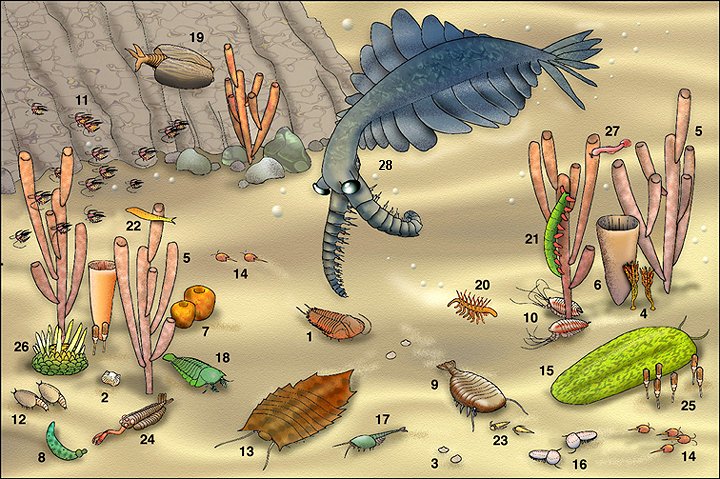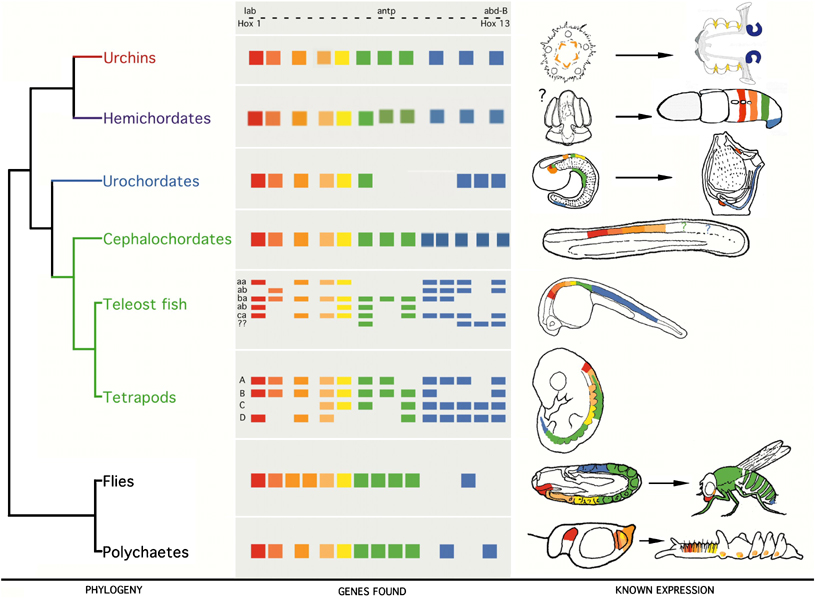A tutorial on the Cambrian explosion
In 1909, our earliest glimpse into what the ancestors looked like of most invertebrates alive today begins with the discovery of the Burgess shale fossil site. It took years to "mine" these fossils and they did not became the focus of serious study until decades later.
BACKGROUND
The earliest morphological evidence for life is 3.5 billion years old, and consists of stromatolites (colonies of cyanobacteria) fossils and single, undifferentiated cells, or Prokaryotes.
For 1.6 billion years these simple cells were the only kind of living organism, until the arrival of Eukaryotes, or single cells with differentiated nuclei and cell organelles. Although representing a large leap in complexity, the Eukaryotes were still only single cells or cell aggregates.
It was another 1.4 billion years before complex, multicellular, and possibly animal life made an appearance in the form of the Ediacaran faunas followed by all the variety of the Cambrian "true" (in that they resemble living) animals about 550 million years ago.
Ediacaran or Vendian fauna
Animals first appear in the fossil record around 580 million years ago as frond-like forms, jellyfish-like imprints, and trace fossils. These fossils appear simultaneously on all continents, except Antarctica, and each assemblage contains roughly the same kinds of forms.
Some of these fossils are simple blobs that are hard to interpret and could represent almost anything. Most have been classified as cnidarians, some are more worm-like with segments, or appear to some taxonomists to be soft-bodied distant relatives of the arthropods. Others are less easy to interpret and may belong to extinct clades with no modern representatives. Vendian rocks also contain trace fossils, probably made by worm-like animals slithering over mud.
After exploring the websites below, answer question one on the study guide.
https://www.youtube.com/watch?v=JzZa_J2NHmQ
This is a great movie, but long. If you have not examined the Ediacaran (Vendian) fossils to any extent, please take the time to view it. It contains some up to date information on how these animals fed and moved. It also contains some suggestions as to relationships among groups that are now being questioned. For example, sponges are not considered by some to be the ancestral clade to most multicellular animals. The material to focus on starts about 23 minutes into the film and ends at 59 minutes into the film. The suggestion made at the end of the film as to the importance of sexual selection in increasing diversity, is very contested, and can be ignored.
A few more to explore if you are interested.
https://www.livescience.com/53337-ediacaran-period-images.html
https://www.livescience.com/63289-ediacaran-leaf-fossil-is-animal.html
https://www.livescience.com/62877-ancient-creature-named-after-obama.html
Cambrian explosion
At the base of the Cambrian period about 545 million years ago, all modern phyla of animals and many algae and protists appear or radiate. This event is sometimes called the "Cambrian Explosion", because of the relatively short time over which this diversity of animal forms appears. We now have several sites where organisms were preserved because they were buried rapidly in mud slides. Cambrian forms lived in much shallower water ecosystems than most Vendian forms. Burgess Shale type assemblages show that this is a radiation of soft-bodied as well as skeletonized organisms or Bauplans in general. Between 60% and 80% of the fossil remains are those of soft organisms.
Examine the diagram below, showing a reconstruction of the Burgess Shale fossils.
(1), brachiopods (2), mollusks (3), and crinoids (4). That is a tiny fraction of the full Cambrian biota, better represented by the Burgess Shale Cambrian fossils. That community includes sponges Vauxia (5), Hazelia (6), and Eifellia (7); brachipods Nisusia (2); priapulid worms Ottoia (8); trilobites Olenoides (1); other arthropods such as Sidneyia (9), Leanchoilia (10), Marella (11), Canadaspis (12), Helmetia (13), Burgessia (14), Tegopelte (15), Naraoia (16), Waptia (17), Sanctacaris (18), and Odaraia (19); lobopods Hallucigenia (20) and Aysheaia (21); mollusks Scenella (3); echinoderms Echmatocrinus (4); and chordates Pikaia (22); among other oddities, including Haplophrentis (23), Opabinia (24), Dinomischus (25), Wiwaxia (26), Amiskwia (27), and Anomalocaris (28). ©2002 by S.M. Gon III (composition & linework) & John Whorrall (color rendering).
Visit this website to explore the history of one of the Cambrian sites, the Burgess shale. View the first 25 minutes of the film. Answer question two.
https://www.youtube.com/watch?v=9N2RkozE4SU
To gain more familiarity with the Cambrian forms, please view the following film, the second in the series, First Life with David Attenborough. View the first 43 minutes.
https://www.youtube.com/watch?v=xevizYKF8n8
All of the Burgess shale fossils, are illustrated on the following website.
http://park.org/Canada/Museum/burgessshale/faunaandflora.html
Here is a diagram to help you compare animals from the two periods and answer question four.
Summary diagram of the Cambrian compared to the Vendian fauna.
Answer questions three and four.
Why the Cambrian explosion?
Most explanations for this radiation involve properties of animals themselves (intrinsic causes), but the coincident events in algae and protozoans suggest perhaps a more ubiquitous, ecologic trigger or extrinsic causes. One possibility is oceanographic changes that increased nutrient supplies to the shallow waters, hence a radiation of trophic links in the food chains of that time. Oxygen levels were increasing for the same reason. After the glacial period, temperatures rose until by the time of the Cambrian itself the climate was warmer than it is today. We also do not know why the innovation stopped. There have been extinctions since the Cambrian but an increase in very different bauplans has not been part of any following radiation of animal forms. Now we have evidence from other "Cambrian" sites. Two other localities that are older have been extensively studied. Chengiang adds many new species to a Burgess shale type setting, and sets the time for the Cambrian explosion back about 10-15 million years. Interestingly enough there are many more chordates and ancestors in this biota.
http://en.wikipedia.org/wiki/Vetulicolia
The Sirius Passet biota is also about 15 million years older but hints at simpler forms (and perhaps living deeper), and also provides more evidence for more worm like and mollusk type of fossils.
Visit the website below, which gives also gives a summary of the possible causes for the Cambrian explosion.
https://burgess-shale.rom.on.ca/en/index.php --------------Go to Science tab, then on the small index to your left on the page, cllick on Origin of animals and the Cambrian explosion, then the Cambrian Explosion. Read about triggers to the explosion.
The Sequence to follow-------------Home > Science > Origin of Animals and the Cambrian Explosion > The Cambrian Explosion >Triggers of the Cambrian explosion. Great website, with unfortunately lots of broken links.
More on molecular evidence and why innovation may have stopped.
The Cambrian explosion is still about 700-300 million years later than the molecular data suggest that animals originated, leaving an enormous period of time without a fossil record. Perhaps, the first animals were small, unskeletonized, or destroyed by geologic processes.
DNA evidence especially as regards coding of ribosomes, indicate that diversification started earlier but support that diversification occurred rapidly on a geological scale. In fact, most of the classification you will learn for invertebrates in this courses rest on comparative ribosomal sequence analysis.
But to understand how crown (major) clades evolved, we need to examine regulatory genes since it is small changes in the developmental pathways that we believe are responsible for the differences we see in phyla or crown (major) clades.
Most of the work to date is on homeobox genes, (or a gene coding for a protein with a particular DNA binding motif known as the homeodomain) that controls axis and overall positioning and are highly conserved in evolutionary time. They encode transcription factors that act as molecular markers for the position of cells along the major body axis.
--------------------------------------------------------------------------------------------
Example of similarity in some developmental genes:
If you compare a single hox gene (MSX gene) from sea urchins and mice: both of them consist of about 180 nucleotides, and both code for a protein of about 60 amino acids. The sequence of amino acids in the sea urchin and the mouse differ only in a single amino acid. The rest have remained the same over 600 million years of evolution.
Hox genes are so amazingly conservative that geneticists can do all sorts of very interesting things with them. They have for example removed a hox eye gene from a fly and replaced it with the equivalent human hox gene in fly embryos. They have also added the human hox gene to mutant fly embryos that lack the normal fly gene for making eyes. The adult flies produced in both cases are absolutely normal flies with a compound eye.
The diagram below illustrates an example of a difference in body plan caused by small changes in the expression of regulatory genes. In this example, gradient differences in some regulatory genes determine whether segments will have appendages.
----------------------------------
This conservatism has a major implication, it means that hox gene clusters probably evolved only once and so all animals evolved from a single ancestor. It also substantiates a radiation over a relatively short geological timespan, although it might have taken place before the Cambrian.
However be cautious, as we still do not know specifics about the bauplan of that ancestor because hox gene clusters can be lost as well as added.
To fully understand animal evolution, we need more information on the next level of regulatory genes, the ones beyond those that control the overall pattern. The ones that control what specific organ, etc. develops at a specific time and place.
But to date there is a take home message.
By the Cambrian animals have evolved all major body or bauplans we see today or some basic genetic toolkit.
Evolution since then has mostly tinkered with variation within a bauplan. So animals have gotten more diverse, but not usually by the appearance of radically new bauplans. In fact, some of these as evidenced by Cambrian and Vendian fossils have disappeared.
The new phylogeny will be based on what we find out how development is controlled and changed not only to get different bauplans, but variations of a bauplan through time. We need to understand how difference in bauplans, such as having or lacking segmentation, have been turned on and off as major clades evolved.
But it looks like by the Cambrian, all surviving animals will share a common genetic toolbox that will result in some major bauplans or combination of that toolkit, that will be tinkered with throughout time to give us more diversity but within a bauplan. That is when most animal crown clades in terms of their "genetic" toolboxes have evolved. That also means we can find an ancestor for most animal crown clades in the Cambrian. So the Cambrian is looked at as a revolution for animal evolution, the age to which most living animal crown clades (at the level of the the old phyla) can trace their ancestry.
A good you tube summary of the take home message.
https://www.youtube.com/watch?v=mxJ1E7-Yie0
Answer question five



